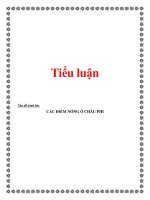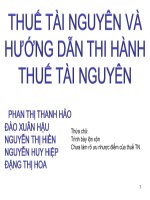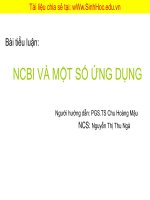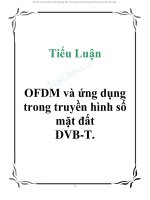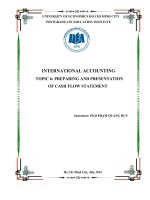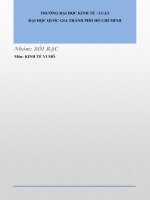tiểu luận thuế và htt ở vn fundamentals and practice of vietnam’s law on environmental protection tax
Bạn đang xem bản rút gọn của tài liệu. Xem và tải ngay bản đầy đủ của tài liệu tại đây (120.08 KB, 29 trang )
1. Fundamental of environmental protection tax in Vietnam
1.1. Adjusting scope
According to environmental protection law no. 57/2010/QH12, the law provides for
taxable subject, un-taxable subject, taxpayers, tax base, tax declaration, tax calculation,
tax payment and environmental protection tax refund.
1.2. Objectives
1.2.1. Taxable subject
There are 9 groups of taxable subjects which is specified by government.
a) Gasoline, oil, grease, including: gasoline, except ethanol; aircraft fuel; diesel oil;
petroleum; fuel oil; lubricants; grease.
b) Coal, including: lignite; anthracite Coal (anthracite); fat coal; other coal.
c) Hydrogen-chlorofluorocarbon liquid (HCFC).
d) Taxable-plastic bag.
c) Herbicide which is restricted from use.
d) Pesticide which is restricted from use.
e) Forest product preservative which is restricted from use.
f) Warehouse disinfectant which is restricted from use.
g) When it is necessary to supplement other taxable objects as per period, the
National Assembly Standing Committee shall consider and regulate.
3
1.2.2. Non-taxable subject
Goods is not specified in Article 3 (taxable subject) of this Law shall not be subject
to environmental tax.
Goods provided for in Article 3 of this Law shall not be subject to environmental tax
in the following cases:
a) Goods transported in transit or transshipped through the border gate, Vietnam border
in accordance with the law, including the transportation of goods from exporting countries to
importing countries through the border gate of Vietnam but it is not made import & export
procedures into and out of Vietnam; transit goods through the border gate, the border of
Vietnam on the basis of agreements signed between the Government of Vietnam and a
foreign government or an agreement between agencies, representative authorized under the
provisions of law by government of Vietnam and foreign governments;
b) Goods temporarily imported for re-export within the time limit prescribed by law;
c) Goods directly exported by production facilities or entrusted for the export
business to export, except for organizations, households and individuals to purchase
goods which environmental protection taxable subject to export.
1.2.3. Taxpayers
- Environmental protection taxpayer is organizations, households and individuals
producing, importing goods under taxable subject provided for in Article 3 of this Law.
- Environmental protection taxpayer in some specific cases shall be provided for as follows:
a) in case of goods importing commission, the person who entrusted importing goods
shall be taxpayer;
4
b) In cases where organizations, households and individuals act procurement hub of
coal to develop small, retail but they can not produce the documents proving that
goods have been paying environmental protection tax, the organizations, households
individuals act as procurement hub shall be taxpayer.
1.3. Tax base
- Tax base of environmental protection is the number of taxable goods and absolute rate.
- The number of taxable goods shall be provided for as follows:
a) For goods produced in the country, the number of taxable goods is the quantity of
goods produced and sold, exchanged, internally consumed, donated;
b) For imported goods, the number of taxable goods is the quantity of imported goods.
- Absolute rate for tax calculation specified in Article 8 (regulated tariff table) of this Law.
1.4. Tax calculation method
The amount of environmental protection tax payable = the quantity of unit of
dutiable goods x absolute rate specified on a unit of goods.
To calculate the payable tax amount, the quantity of the taxable goods unit and the
absolute tax rate set by the government shall be calculated. Specifically:
- Quantity of taxable goods units is determined as follows:
+ Domestically produced goods: The quantity of taxable goods is the quantity of
manufactured goods exchanged, exchanged, internal consumed, donated, promoted and
advertised.
+ Imported goods: The quantity of taxable goods is the quantity of imported goods.
5
+ Goods being mixed fuels containing petrol and oil, etc. The number of taxable goods in
the period is the quantity of fossil-based petrol, oil and grease included in the volume of
mixed fuels imported or produced, sold or given. exchanged, donated or put into internal
consumption, which are converted into units of measurement and tax calculation
regulations of the corresponding goods. The method of determination is as follows:
Quantity of fossil-based petrol, oil and grease calculated tax = Quantity of imported fuel,
imported, sold, consumed, exchanged or donated x Percentage of fossil-based gasoline,
oil, grease found in mixed fuels
+ For multi-layer plastic bags manufactured or processed from single plastic HDPE,
LDPE, LLDPE and other plastic films (PP, PA, ...) or other substances such as aluminum,
paper ... Environmental protection is determined by the percentage of weight of single
plastic film HDPE, LDPE, LLDPE contained in multi-layer plastic bags.
- Absolute tax rate per unit of goods
According to Clause 1, Article 1 of Resolution 579/2018 / UBTVQH14, the
absolute tax rate for 1 unit of goods is set by the State for each type of goods as follows:
Table 1.1. Environmental protection tax schedule
No. Product
Unit
Tax rate
(VND/unit)
I
Petrol, oil, grease
liter
1
Gasoline, except ethanol
liter
4.000
6
2
Flying fuel
liter
3.000
3
Diesel oil
liter
2.000
4
Fuel
liter
1.000
5
Mazut oil
liter
2.000
6
Lubricant
liter
2.000
7
Greasy
II
Coal
ton
1
Brown coal
ton
15.000
2
Anthracite (anthracite)
ton
30.000
3
Fat coal
ton
15.000
4
Other coal
ton
15.000
III
Hydro-chloro-fluoro-carbon (HCFC) solution,
including HCFC, contained in a mixture
containing HCFC solution
kilogram 2.000
kilogram 5.000
7
IV
Taxable Plastic bags
kilogram 50.000
V
Herbicides are of limited use
kilogram 500
VI
Termiticides are of limited use
kilogram 1.000
VII Forest preservatives are of limited use
kilogram 1.000
VIII Warehouse disinfectants are of limited use
kilogram 1.000
1.5. Tax declaration, tax calculation and tax refund
- The tax declaration, tax calculation, tax payment for environmental protection on goods
produced and sold, exchanged, internally consumed, donated shall be made by the month
and the provisions of the law on tax administration.
- The tax declaration, tax calculation, tax payment for environmental protection on imported
goods shall be made at the same to time of import tax declaration and tax payment.
- Environmental protection tax is only paid once for goods produced or imported.
In addition, Article 11 regulates about the tax refund
Environmental protection taxpayer is paid tax refund in the following cases:
- Imported goods are still stored in warehouse, storage at the border gate and are subject
to be supervised by the customs authority for re-export to foreign countries;
8
- Imported goods to transport, sell abroad through agents in Vietnam; gasoline, petrol sold
for vehicles of foreign firms on the route through Vietnam's ports or means of Vietnam's
transportation on international transport road under the provisions of law;
- Goods temporarily imported for re-export by business mode of temporary import for reexport;
- Goods imported by the importer re-exporting to foreign countries;
- Goods temporarily imported for participation in fairs, exhibitions and introduction of
products in accordance with the law when re-exported to foreign countries.
9
2. Impact of Environmental Protection Tax
2.1. Economy
Environmental Protection Tax (EPT) is applicable to the production and importation
of certain goods which are considered as detrimental to the environment, the most
significant of which are petroleum and coal.
2.1.1. Demand side (Tax collector)
Without government intervention, there is no market incentive for companies and
individuals to take into account environmental damage, because its impact is spread
across many people and it has little or no direct impact on whom made environmental
contamination. Therefore, protection of the environment requires collective action, led by
taxation system of government. In other words, government is tax collector, who indicates
the demand side of Environmental Protection Tax.
Environmental taxes have many important effects, such as the ability to raise
public revenue and economic efficiency.
2.1.1.1 Revenue from Environmental Protection Tax
2.1.1.1.1 Environmental Protection Tax Hikes
On 20/09/2018, the National Assembly's Standing Committee passed a resolution
which raises the EPT on some main types of goods and will take effect from January 1,
2019.
10
Table 1.1. Effects of Environmental Protection Tax Hikes
No. Goods
Unit Tax rate
(VND)
Adjusted tax rate Changes
(VND)
(VND)
(
1
Gasoline
liter 3,000
4,000
+1,000
2
Diesel
liter 1,500
2,000
+500
3
Heavy fuel oil and lubricants
liter 900
2,000
+1100
4
Coal
ton
10,000
15,000
+5,000
5
HCFCs
kg
4,000
5,000
+1,000
6
Plastic bags (*)
kg
40,000
50,000
+10,000
7
Restricted use chemicals
kg
500 - 1,000 500 - 1,000
0
Excludes plastic bags used for packaging or which are “environmentally friendly”
(Source: Resolution 579/2018/UBTVQH14 promulgating environmental taxes,
taken effect on 01/01/2019)
2.1.1.1.2 Reduction of importation
Petroleum products have become a major revenue source of Vietnam with
proceeds from import duty on petrol and oil now accounting for around 7% of the
11
government income. Statistics released by the General Department of Customs
showed that in the first 8 months of 2018, oil and petroleum product imports
reached 8.63 million tons, while the import value stood at USD 5.74 billion, an
increase of 27.3% over the same period of 2017.
However, this revenue source is now on the decrease because import duty
rates on petrol products have decreased considerably over the last few years due to
the country’s tariff commitments. Vietnam is now offering the most-favored-nation
import duty rates to all WTO members under which the maximum duty rate
applicable to petrol is 40%. Particularly for exporters from ASEAN countries,
since 2012, the preferential import duty rates of petrol, jet fuel, kerosene, diesel oil,
and fuel oil have been 20%, 10%, 7%, 5%, and 0%, respectively. Meanwhile,
exporters from the Republic of Korea have enjoyed the preferential duty rate of
10% for petrol and 5% for oil since 2016. These preferential tariffs will be
gradually reduced to 0%.
As reported by the Financial Times online, the proceeds from import duty
on petroleum products have sharply reduced from VND 53 trillion (USD 2.3
billion) in 2015 to VND 14.1 trillion (USD 613 million) in 2017. It is estimated
that the tax increase would annually bring about more than VND 15.7 trillion
(USD 672 million) to the government coffers.
Against the backdrop of the decrease in revenue from import duty, the
environmental tax will undoubtedly need to go up to balance the government
budget. In other words, EPT will be used to compensate for the reduction in
import-export taxes.
12
2.1.1.2 Economic Efficiency of Environmental Protection Tax
2.1.1.2.1 Low expenditure on environmental protection
The concern of economic efficiency is how environmental tax revenues will
be spent. According to Dr. Dinh Tuan Minh, an economic expert, speaks to the
Nông thôn ngày nay (Countryside Today) newspaper: “The nature of the
environmental protection tax in Vietnam is not a sum of money to be used in a
specific purpose or a special economic field. The collected money will be put into
the government budget. Of course, a small sum will be disbursed in environmental
protection. In other words, the environmental tax will be used to compensate for
the reduction in import-export taxes.”
He also said: “When we want to increase the government budget through
increases in environmental protection tax, it is likely that the environmental
message might be misunderstood. A key problem here is that the collected money
is not predominantly used for the environment, but for many other activities. In its
report, the Ministry of Finance (MOF) didn’t explain how the environmental tax
would be used.”
Dr. Le Thi Thuy Van, head of the Department of Science Management and
International Cooperation, Financial Strategy and Policy Institute under the umbrella
of the MOF, said annual government budget allocations for environmental activities
amounted to more than 1% of total expenditures in the government budget
expenditure estimate. "The total government budget for environmental protection
tasks in the 2013-2018 period is VND 72.42 trillion. Of which, the central budget is
VND 10 trillion, and the local budget is VND 62.42 trillion," Van said.
13
National Assembly Chairwoman Nguyen Thi Kim Ngan said all proceeds
from the collection of environmental tax should be remitted into the government
budget and used for environmental protection work. “That way, people will see
that the money is not spent for other purposes,” she said.
However, Vietnam gained VND 42.4 trillion (USD 1.84 billion) in revenue
from the EPT in 2016, jumping nearly 57% from 2015. During the same period,
spending on environmental protection reached just VND 12.3 trillion, making up
29% of the tax revenue.
2.1.1.2.2 Modest results from environmental protection
The government has used central and local budgets as well as official
development assistance resources to invest in programs and projects related to
green growth. Green growth is a way to achieve economic development while
preserving the environment, preventing the loss of biodiversity and minimizing the
unsustainable use of natural resources, according to the Organization for Economic
and Cooperation Development. According to data from MOF, the Government
spent VND 930 billion executing the National Target Program on Energy
Efficiency and Conservation in the 2012-2015 period; VND 49.32 trillion on the
Forest Protection and Development Plan in the 2011-2020 period; VND 5.86
quadrillion on the National Target Program to overcome pollution and improve the
environment in the 2013-2015 period; and VND 1.77 trillion on executing the
National Target Program on climate change.
However, Dr. Le Thi Thuy Van acknowledged that budget spending among
some budget-using units was scattered, ineffective and misused for other purposes,
such as the allocation of environmental investigative tasks and surveys. Besides this,
14
Vietnam has not paid much attention to the allocation of funds for the
improvement of the criteria and technical standards on environmental protection.
Meanwhile, private-sector investment in environmental protection is low, so
the government budget is still the main source of funding. In some localities
subject to budget constraints, the relevant parties still propose the central
Government supplement the budget for environmental pollution treatment.
The solution of MOF here is restructuring government budget expenditure in
the direction of green finance to ensure the performance of economic and social
development tasks is one of the important tasks of the Financial Strategy up to 2020.
The tax must be credible and its rate predictable in order to motivate
environmental improvements. Economic efficiency requires transparency and
management ability of government.
2.1.2. Supply side (Taxpayers)
2.1.2.1 Individuals/Households
There is concern over the negative effects of this tax. Household consumption
accounts for over two-thirds of total GDP. Higher taxes and reduced subsidies for
government-controlled goods such as healthcare services, electricity, among others, will
put a certain burden on individual expenditures.
Tax levied on diesel/petrol is calculated per head as almost everyone uses it in their
daily travel by one means of transport or another. The additional $690 million to the
government budget per annum actually came from the pockets of all 3 subjects of EPT.
This hike in the petrol tax is just like the hike in the electricity tariff in late 2017.
15
Chairman of the Hanoi Supermarket Association Vu Vinh Phu said “the increase of
environmental tax on petrol and oil will push up transport freights and as a result the prices of
essential commodities will rise. “The burden will finally fall on consumers,” he added.
It is indisputable that tax levied on diesel/petrol is kind of a tax levied on all daily
essential goods. Undoubtedly, the increase in the diesel/petrol price will push market
prices up. Higher prices do harm to individuals, especially to whom have income below
the poverty line. In other words, poverty population suffer the heavy burden of higher
prices, or the hardest hit will be poor people. This is a common theory applied to all
essential goods in society.
2.1.2.2 Enterprises
According to Dan Tri newspaper regarding the decision to raise the EPT, senior
economist Le Dang Doanh said such a tax hike will lead to an increase in transport
charges as well as the production costs of all products and services, thus lowering
enterprises’ competitiveness and contributing to a rise in inflation.
In particular, the increase in the EPT for one litre of petrol by VND 1,000 (due to
Resolution 579/2018/UBTVQH14) will make consumption prices of all market items rise.
However, the hardest-hit sector will be the transport sector. To compensate for that,
transport enterprises will increase their fares and service charges. This is an unavoidable
consequence.
2.2. Environment
The tax rate should be commensurate with the environmental damage.
16
2.2.1. Exploitation of Mineral Resources
For many years, Vietnamese entertained an illusion about the country’s rich natural
resources, believing that they have “gold forests and silver seas”. Only recently, have
Vietnamese changed their mind.
Nguyen Thanh Son, former director of the management board of the Coal Projects in
Red River Delta, said Vietnam not only needs to strive to reduce its reliance on natural
resources, but also needs to reduce exploitation as soon as possible.
With its huge reserves, Vietnam is the third largest mineral producer in the Southeast
Asian region. In fact, over the past two decades, many types of Viet Nam’s minerals have
been mined significantly and are at risk of depletion.
Statistics from the General Statistics Office of Vietnam (GSO) showed that the mining
industry has posted a record slump since 2011, with the growth rate dropping by 7.1% in
2017 and 4% in 2016. This could also lead to an alarming conclusion – the mining industry
will be unable to return to growth, and so the growth pattern must be transformed.
The GSO attributed the slump to the plummet in crude oil and coal exploitation. This
consequence is directly related to Vietnam’s past development strategy, when the mining
industry still occupied an important position. Previously, at the initial stage of
development, the extraction of natural resources such as oil, coal and minerals played a
central role in the economy.
However, the proportion of the mining industry still accounting for about 10% of
GDP is too large, in the context of increasing difficulties in exploitation and fluctuations
of price and supply-demand in the global market.
17
2.2.2. Extraction of Fossil Fuels
In terms of petroleum business field, the environmental tax increased by 1,000 VND/liter
from 01/01/2019. According to Production and business results in 2018 of PVOIL, because of
all that, customers only buy enough essential needs to reduce inventory, causing a decline in
business output of PVOIL in November and December, affect PVOIL’s completion of the 5month production plan and the whole 2018 plan. In accordance with the requirements of the
Government, PVOIL has successfully replace RON 92 gasoline with E5 RON 92 (commonly
E5 bio-fuel) gasoline from the beginning of 2018.
Since petroleum diesel and gasoline consist of blends of hundreds of different
chemicals of varying hydrocarbon chains, many of these are hazardous and toxic. They
include volatile compounds such as benzene, toluene and xylene that are identified as
responsible for the health hazards and pollution associated with the combustion of
petroleum-based fuels.
The process to produce E5 bio-fuel include 3 main components: biodiesel (diesel
alternative), biogasoline and biogas (fermentation of carbohydrates from various
feedstocks, such as corn, sugar cane, wood).
The combustion of fossil fuels such as coal, oil and natural gas has been identified as a
major cause of the increase in the concentration of carbon dioxide in the earth’s atmosphere.
Carbon dioxide and other so-called greenhouse gases allow solar energy to enter the earth’s
atmosphere but reduce the amount of energy that can be radiated back into space, thus
trapping energy and causing global warming. The environmental benefit of replacing fossil
fuels with biomass-based fuels is that the energy obtained from biomass does not add to the
level of carbon dioxide in the atmosphere that causes global warming.
18
In conclusion, that the exploitation of mineral resources and extraction of fossil fuels
are both at lower level will gradually contribute to environmental improvement.
2.3. Society
2.3.1. Consumption of Environmentally Friendly Alternatives
Applying the EPT could change people’s consumption behaviour. For example, to
prompt them to use environmentally-friendly goods; or to levy heavy taxes on nylon or
hydrochlorofluorocarbons (HCFC) and others.
The increase in EPT would have an effect on the transport industry. However, the
government hopes that the tax hike can help increase the use of environmentally friendly
products, such as E5 bio-fuel.
Deputy Minister of Industry and Trade (MOIT) Do Thang Hai said that according to
the roadmap outlined by the Government, E5 bio-fuel has been sold nationwide instead of
RON92 petrol since January 1, 2018, in a bid to protect the environment.
In 2017, the E5 bio-fuel accounts for only 9% of the total petroleum consumption in
domestic market. Additionally, several enterprises have claimed that the consumption of
E5 has not been as high as RON92 and recommended that the sale of E5 was suspended.
For instance, in the first 2 months of 2018, Ho Chi Minh City One Member Limited
Liability Oil and Gas Company (Saigon Petro) said that the consumption of E5 accounted
for less than 30% of its total petrol consumption, while the consumption of RON92
accounted for over 65%.
However, after the first 2 months in 2018, the figure was more positive. According to
the reports of petrol companies, during 2 months in 2018 (March and April), the volume
that E5 was sold accounted for about 42% of the total types of petrol distributed in the
19
market. Compared with 2017, E5 bio-fuel domestic consumption has increased sharply by
nearly 33%. Several petrol companies have posted large consumption of E5, including
Thien Minh Duc Petro with an increase of more than 70%; Military Petroleum
Corporation, up 64.3%; and Petrolimex, up over 48%.
According to economists, bringing new kinds of commodities to market requires a
relatively long period of time to control the market. Because E5 bio-fuel has been put into
service for more than 1 year, the figures cannot reflect the situation adequately. Requiring
this new product to completely replace an old product which had been sold in the market
for several decades is impossible.
2.3.2. Awareness and Action
Law on Environmental Protection Tax aims to raise public awareness about
environmental protection, besides create more revenues to fund environmental protection
activities.
Action must follow awareness. Understanding awareness of pollution and support
for environmental protection from the general public is essential for informing
governmental approaches to dealing with this problem.
Take the example of imposing EPT on nylon in Ho Chi Minh City:
Table 2. Change in quantity of nylon in Ho Chi Minh city in 2014 and 2017
(Unit:
Quantity of nylon
Quantity of nylon
Quantity of nylon
tons/year)
produced
imposed EPT
imported
2014
23,000
746
63,8
2017
33,400
577
220
20
The rate of quantity of nylon imposed per quantity of nylon produced in 2014 and
2017 was 3.24% and 1.73%, respectively. While the quantity was higher over 3 years,
there was a drop in this rate. This proved the lack of awareness and action.
In summary, taxpayers need to raise self-awareness about current situation of
surroundings’ pollution. Besides, they have to make obligations to pay tax actively and on
time.
21
3. Applications in practice
3.1. Practical situation
One of the main taxable objects of Environment Protection Tax are businesses
(individuals and organizations), which also play an important part in leading
environmental protection and the sustainable development of Vietnam. Although the
levels of pollution nowadays remain extremely high in the country, many businesses are
unable to build more efficient and modern waste processing systems or are not
environmentally responsible for society. Processing of solid waste remains insufficient,
water pollution at industrial parks is a major issue, and small businesses are not able to
process their waste efficiently. Nguyen The Chinh, rector at the Institute of Strategy and
Policy on Natural Resources and Environment, said that the use of modern technology at
companies was not as prevalent as in other developed countries, while production from
industrial clusters and facilities contributes greatly to worse pollution. The more and more
serious environmental accidents have been occurring from industry to society.
Positively, Environment Protection Tax is considered as one of the economic tools that
bring high efficiency in environmental management. Because Environment Protection Tax is
based on the principle that individuals or organizations using polluting products must pay
taxes, the big producers of waste must try their best to find new methods to protect the
environment and contribute to a green economy and sustainable development. Before
applying this tax, the selling price of goods and services did not include social costs, which is
easy for individuals and businesses to make profit. Nowadays, Environment Protection Tax
increases the price of products and goods, which directly affects profitability, forcing
businesses to raise environmental awareness, contributing to limiting production and
consumption of polluting products. More businesses, therefore, are becoming
22
environmentally friendly, with green products and green practices, such as a number of
supermarkets now wrapping vegetables in banana leaves instead of using plastic bags.
In Vietnam, nine leading companies in FMCG and packaging industries (Coca
Cola, FrieslandCampina, La Vie, Nestlé, NutiFood, Suntory PepsiCo, Tetra Pak, TH
Group and URC Việt Nam) joined hands to launch the coalition Packaging Recycling
Organization Vietnam (PRO) in HCM City on June 21, 2019. Some big brands such as
Coca-Cola, Evian, Starbucks, McDonald's, ... have continuously taken actions to reduce
plastic waste pollution in their own production and service processes. Besides, Comfort,
Sunlight, Love Beauty and Planet, big brands of Unilever Group, have changed into
100% recycled plastic, biodegradable bags instead of disposable plastic bags for product
packaging; Lotte Mart use banana leaves and bagasse bags instead of disposable plastic
bags; Saigon Co.op also stopped selling plastic straws at more than 600 large and small
supermarkets in Vietnam and so on. Recently, Nestlé Vietnam signed a commitment to
achieve major goals including: completely recycling and reusing 100% of product
packaging by 2025; 100% of the factory's waste is collected and sorted at source; 100% of
factories do not bury solid waste into the environment.
In addition, many companies have actively directed the organization to launch a
movement to collect disposable plastic waste. Being environmentally friendly helps
businesses create a safe working environment, reduces costs related to their resource
usage, and boosts their brand image and competitiveness.
However, the Environment Protection Tax in legal documents is quite general, which
are very faint and difficult to implement and execute in reality. Besides, the conflict in the
regulation makes the application process much more difficult. In some cases, the relatively
big gap between the minimum and the maximum tax amount applied for a commodity leads
to the possibility that the application will not be fair for businesses that
23
produce the same products but in other regions. This has led to a number of cases where
the subjects that were supposed to be taxed were not taxed, while in contrast the subjects
that are not taxable were quite heavily taxed. Therefore, although there are already
guiding regulations on this tax issue, it does not seem to solve these existing problems.
Another example, recently, according to the latest draft resolution on Environment
Protection Tax, the Ministry of Finance proposed increasing the amount of taxes with items
including gasoline, oil... Specifically, from July 1, 2018, the environment protection tax on
gasoline will increase by 1,000 VND per liter from 3,000 VND to 4,000 VND per liter, in
order to ensure the stability of the policy, in accordance with the roadmap to replace import
taxes as international commitments and to avoid petrol smuggling. In addition to gasoline, the
Ministry of Finance also proposed increasing the environmental tax on diesel goods by 500
VND per liter; madut oil, lubricant and grease are also recommended to increase 1,000 VND
per liter. However, the imposition of this tax will push up the price of gasoline in Vietnam
while the average income of the people in Vietnam is still quite low, which directly affects the
rights of people and businesses. Mr. Nguyen Minh Duc - Legal Department (VCCI) has
stated that "it is impossible to make excuses to offset the budget deficit by raising the tax
bracket with petrol and oil". Therefore, this proposal has met a lot of mixed opinions of both
people and experts in the economic field.
Another matter of concern is how environmental tax revenues will be spent.
National Assembly Chairwoman Nguyen Thi Kim Ngan said all proceeds from the
collection of environmental tax should be remitted into the state budget and used for
environmental protection work. “That way, people will see that the money is not spent for
other purposes,” she said.
Vietnam gained VND 42.4 trillion (USD 1.84 billion) in revenue from the
environmental protection tax in 2016, jumping nearly 57 percent from 2015. During the
24
same period, spending on environmental protection reached just VND 12.3 trillion,
making up 29 percent of the tax revenue. In the period 2012-2016, the revenues from
environmental protection tax continuously increased over the years. The total revenues of
environmental protection tax in 2012 were 11,160 billion VND, in 2013 were 11,512
billion VND, in 2014 were 11,970 billion VND, in 2015 were 27,020 billion VND and in
2016 were estimated at 42,393 billion VND. The revenues of environmental protection
tax accounted for approximately 1.5% - 4.1% of the total State budget revenues and 0.3%
- 0.9% of GDP annually.
The Environment Protection Tax in Vietnam has not covered the harm of the
pollution and waste producers, the tax rate has not been studied in the direction of the
proposed effectiveness while there is still a situation of applying taxes under
governmentally budgetary pressure. The law has not yet ensured an appropriate
mechanism to mobilize the participation and contribution of all organizations and
individuals to participate in environmental protection. Therefore, the current protection of
the environment seems to be the job of the authorities, but has not really become "the
responsibility of the entire people".
3.2. Case study
In Vietnam, Environment Protection Tax is partly applied on plastic bags according to
the weight on average, each kilogram of taxable-disposable bag will have about 200-500
pieces will be charged an amount of tax about 50.000 VND. Even though it seems inefficient,
many experts believe that it is impossible to tax on plastic bags by each piece in Vietnam.
The current Law on environmental protection tax only stipulates general provisions related to
plastic bags, which causes many problems in the identification of taxable plastic bags. In
order to solve this problem, the Government issued Decree No.
25
69/2012/ND-CP regulating that plastic bags are subject to tax and put this provision in the
Law on Environmental Protection Tax to enhance the legality.
According to statistics, the rate of environmental protection tax on nylon bags in
the three years from 2014 to 2016 is about 50 to 70 billion VND, compared to the actual
use as a very little part. In contrast, in some developed countries like England or Iceland,
the tax on plastic bags is imposed on each bag and each is incurred a tax of about 4,500
VND or more.
According to Article 3 of the Law on Environment Protection Tax 2010, for multilayer plastic bags manufactured or processed from single plastic HDPE, LDPE, LLDPE
and other plastic films (PP, PA, ...) or other substances such as aluminum, paper …, the
Environment Protection Tax is determined by the ratio of the weight of single plastic
HDPE, LDPE, LLDPE in multi-layer plastic bags. Taxable-plastic bags will be taxed from
30.000VND to 50.000VND per each kilogram.
It is estimated that by Ho Chi Minh City Department of Natural Resources and
Environment, in 2017, 80,000 tons of plastic bags were discharged into the environment.
However, the proportion of plastic bags collected and recycled by waste treatment
companies is only 38%.
In particular, the number of plastic bags discharged into the environment is
increasing sharply, from about 40 tons/day in 2008 to 228 tons/day in 2017. Contrast to
the reality, the amount of environmental protection tax paid to the state budget is
decreasing, from 746 tons in 2014 to 577 tons in 2017, down 23%. On the other hand, the
number of imported plastic bags also increased greatly, nearly 250% after 4 years, from
2014 was 63.8 tons to 220 tons in 2017.
26
The audit also shows that the policy inadequacy is that bags without bottoms are not
taxable. In fact, when going to buy coffee without drinking at the shop, the sellers often put
cups in bags for customers to take home. These bags without bottom are not taxable.
To clarify the inadequacies in tax management for plastic business households, the
audit team asked Ho Chi Minh City Power Company to provide the electricity
consumption of the plastic bag producing households.
Surprisingly, the amount of electricity that most households produce plastic bags is
up to 8 times higher than the taxable revenue. For example, the revenue of tax declaration
is VND 100-200 million / year, but based on the electricity cost to produce plastic bags,
the actual revenue can reach over VND 1 billion.
The allocation of taxes to small producers has led to a high taxation policy to push
up the price of plastic bags. Most of the plastic bags used by many markets and shopping
places on the street are produced by small establishments.
3.3. Discussion
A general principle of taxation is that taxes should as far as possible be levied on final
products, consumption and incomes. Taxes levied on intermediary products impose additional
economic costs by distorting methods of production. The scope of Environment Protection
Tax should ideally be as broad as the scope of the environmental damage, even much broader.
The tax rate should be commensurate with the environmental damage. It should be credible
and its rate predictable in order to motivate environmental improvements. Policy makers need
to consider the impact of such taxes on groups such as low-income households or pollutionintensive, trade-exposed businesses. Environmental tax revenues can assist fiscal
consolidation or help to reduce other taxes. Distributional impacts can, and generally should,
be addressed through other policy instruments.
